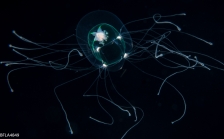RAS taxon details
Bougainvillia Lesson, 1830
117015 (urn:lsid:marinespecies.org:taxname:117015)
accepted
Genus
Perigonimus M. Sars, 1846 · unaccepted (synonym)
marine, terrestrial
Lesson, R.P. (1830). Voyage autour du monde : exécuté par ordre du roi, sur la corvette de Sa Majesté, la Coquille, pendant les années 1822, 1823, 1824, et 1825, par M. L.I. Duperrey. <em>Zoologie 2,.</em> Paris, 1826-1830. (vol. 2, pt 2, 2e division, 1830)., available online at https://www.biodiversitylibrary.org/page/38663489
page(s): 118 [details]
page(s): 118 [details]
Schuchert, P.; Choong, H.; Galea, H.; Hoeksema, B.; Lindsay, D.; Manko, M.; Pica, D. (2025). World Hydrozoa Database. Bougainvillia Lesson, 1830. Accessed through: RAS (Eds.) (2025) Register of Antarctic Species at: https://ras.biodiversity.aq/aphia.php/www.pfeil-verlag.de/04biol/rest/aphia.php?p=taxdetails&id=117015 on 2025-09-12
RAS (Eds.) (2025). Register of Antarctic Species. Bougainvillia Lesson, 1830. Accessed at: https://ras.biodiversity.aq/aphia.php/www.pfeil-verlag.de/04biol/www.pfeil-verlag.de/04biol/aphia.php?p=taxdetails&id=117015 on 2025-09-12
Date
action
by
original description
Lesson, R.P. (1830). Voyage autour du monde : exécuté par ordre du roi, sur la corvette de Sa Majesté, la Coquille, pendant les années 1822, 1823, 1824, et 1825, par M. L.I. Duperrey. <em>Zoologie 2,.</em> Paris, 1826-1830. (vol. 2, pt 2, 2e division, 1830)., available online at https://www.biodiversitylibrary.org/page/38663489
page(s): 118 [details]
original description (of Perigonimus M. Sars, 1846) Sars, M. (1846). Fauna littoralis Norvegiae oder Beschreibung und Abbildungen neuer oderwenig bekannter Seethiere, nebst Beobachtungen über die Organisation,Lebensweise und Entwickelung derselben. 1-194. Johann Dahk. Christiania., available online at https://www.biodiversitylibrary.org/page/45526545
page(s): 8 [details]
context source (Hexacorallia) Fautin, Daphne G. (2013). Hexacorallians of the World. (look up in IMIS) [details]
basis of record van der Land, J.; Vervoort, W.; Cairns, S.D.; Schuchert, P. (2001). Hydrozoa, <B><I>in</I></B>: Costello, M.J. <i>et al.</i> (Ed.) (2001). <i>European register of marine species: a check-list of the marine species in Europe and a bibliography of guides to their identification. Collection Patrimoines Naturels,</i> 50: pp. 112-120 (look up in IMIS) [details]
additional source Brunel, P., L. Bosse & G. Lamarche. (1998). Catalogue of the marine invertebrates of the estuary and Gulf of St. Lawrence. <em>Canadian Special Publication of Fisheries and Aquatic Sciences, 126.</em> 405 pp. (look up in IMIS) [details] Available for editors
additional source Cairns, S.D., L. Gershwin, F.J. Brook, P. Pugh, E.W. Dawson, O.V. Ocaña, W. Vervoort, G. Williams, J.E. Watson, D.M. Opresko, P. Schuchert, P.M. Hine, D.P. Gordon, H.I. Campbell, A.J. Wright, J.A.Sánchez & D.G. Fautin. (2009). Phylum Cnidaria: corals, medusae, hydroids, myxozoans. <em>in: Gordon, D.P. (Ed.) (2009). New Zealand inventory of biodiversity: 1. Kingdom Animalia: Radiata, Lophotrochozoa, Deuterostomia.</em> :59-101., available online at https://repository.si.edu/handle/10088/8431 [details] Available for editors
additional source Nogueira M., Rodriguez C. S., Mianzan, H., Haddad M. A., Genzano G. (2013). Description of a new hydromedusa from the southwestern Atlantic Ocean, Bougainvillia pagesi sp. nov. <em>Cnidaria, Hydrozoa, Anthoathecata). Marine Ecology.</em> 34: 113-122., available online at https://doi.org/10.1111/maec.12030
page(s): Table 1; note: tabular compilation of all known species [details]
additional source Bouillon, J.; Boero, F. (2000). Synopsis of the families and genera of the Hydromedusae of the world, with a list of the worldwide species. <i>Thalassia Salent. 24</i>: 47-296 (look up in IMIS) [details]
page(s): 118 [details]
original description (of Perigonimus M. Sars, 1846) Sars, M. (1846). Fauna littoralis Norvegiae oder Beschreibung und Abbildungen neuer oderwenig bekannter Seethiere, nebst Beobachtungen über die Organisation,Lebensweise und Entwickelung derselben. 1-194. Johann Dahk. Christiania., available online at https://www.biodiversitylibrary.org/page/45526545
page(s): 8 [details]
context source (Hexacorallia) Fautin, Daphne G. (2013). Hexacorallians of the World. (look up in IMIS) [details]
basis of record van der Land, J.; Vervoort, W.; Cairns, S.D.; Schuchert, P. (2001). Hydrozoa, <B><I>in</I></B>: Costello, M.J. <i>et al.</i> (Ed.) (2001). <i>European register of marine species: a check-list of the marine species in Europe and a bibliography of guides to their identification. Collection Patrimoines Naturels,</i> 50: pp. 112-120 (look up in IMIS) [details]
additional source Brunel, P., L. Bosse & G. Lamarche. (1998). Catalogue of the marine invertebrates of the estuary and Gulf of St. Lawrence. <em>Canadian Special Publication of Fisheries and Aquatic Sciences, 126.</em> 405 pp. (look up in IMIS) [details] Available for editors
additional source Cairns, S.D., L. Gershwin, F.J. Brook, P. Pugh, E.W. Dawson, O.V. Ocaña, W. Vervoort, G. Williams, J.E. Watson, D.M. Opresko, P. Schuchert, P.M. Hine, D.P. Gordon, H.I. Campbell, A.J. Wright, J.A.Sánchez & D.G. Fautin. (2009). Phylum Cnidaria: corals, medusae, hydroids, myxozoans. <em>in: Gordon, D.P. (Ed.) (2009). New Zealand inventory of biodiversity: 1. Kingdom Animalia: Radiata, Lophotrochozoa, Deuterostomia.</em> :59-101., available online at https://repository.si.edu/handle/10088/8431 [details] Available for editors
additional source Nogueira M., Rodriguez C. S., Mianzan, H., Haddad M. A., Genzano G. (2013). Description of a new hydromedusa from the southwestern Atlantic Ocean, Bougainvillia pagesi sp. nov. <em>Cnidaria, Hydrozoa, Anthoathecata). Marine Ecology.</em> 34: 113-122., available online at https://doi.org/10.1111/maec.12030
page(s): Table 1; note: tabular compilation of all known species [details]
additional source Bouillon, J.; Boero, F. (2000). Synopsis of the families and genera of the Hydromedusae of the world, with a list of the worldwide species. <i>Thalassia Salent. 24</i>: 47-296 (look up in IMIS) [details]
 Present
Present  Inaccurate
Inaccurate  Introduced: alien
Introduced: alien  Containing type locality
Containing type locality

